DR Towable Backhoe User Manual

DR® TOWABLE BACKHOE
SAFETY & OPERATING INSTRUCTIONS
|
|
DR Power Equipment |
Serial No. |
|
Toll-free phone: 1-800-DR-OWNER (376-9637) |
|
Fax: 1-802-877-1213 |
|
Order No. |
|
|
|
Website: www.DRpower.com |
|
|
|
Read and understand this manual and all instructions before operating the DR TOWABLE BACKHOE.

Table of Contents
Chapter 1: General Safety Rules |
3 |
Chapter 2: Setting Up The DR TOWABLE BACKHOE |
8 |
Chapter 3: Operating The DR TOWABLE BACKHOE |
12 |
Chapter 4: Maintaining The DR TOWABLE BACKHOE |
19 |
Chapter 5: Troubleshooting |
22 |
Chapter 6: DR TOWABLE BACKHOE Accessories |
24 |
Chapter 7: Parts Lists, Schematic Diagrams And Warranty |
26 |
Conventions used in this manual
This indicates a hazardous situation, which, if not followed, will result in death or serious injury.
This indicates a hazardous situation, which, if not avoided, could result in death or serious injury.
This indicates a hazardous situation, which, if not avoided, could result in minor or moderate injury.
This information is important in the proper use of your machine. Failure to follow this instruction could result in damage to your machine or property.
Serial Number and Order Number
A Serial Number is used to identify your machine and is located on the Serial Number Label on your machine. An Order Number is used to check and maintain your order history and is located on the upper left portion of your packing slip. For your convenience and ready reference, enter the Serial Number and Order Number in the space provided on the front cover of this manual.
Additional Information and Potential Changes
DR Power Equipment reserves the right to discontinue, change, and improve its products at any time without notice or obligation to the purchaser. The descriptions and specifications contained in this manual were in effect at printing. Equipment described within this manual may be optional. Some illustrations may not be applicable to your machine.
2 DR® TOWABLE BACKHOE
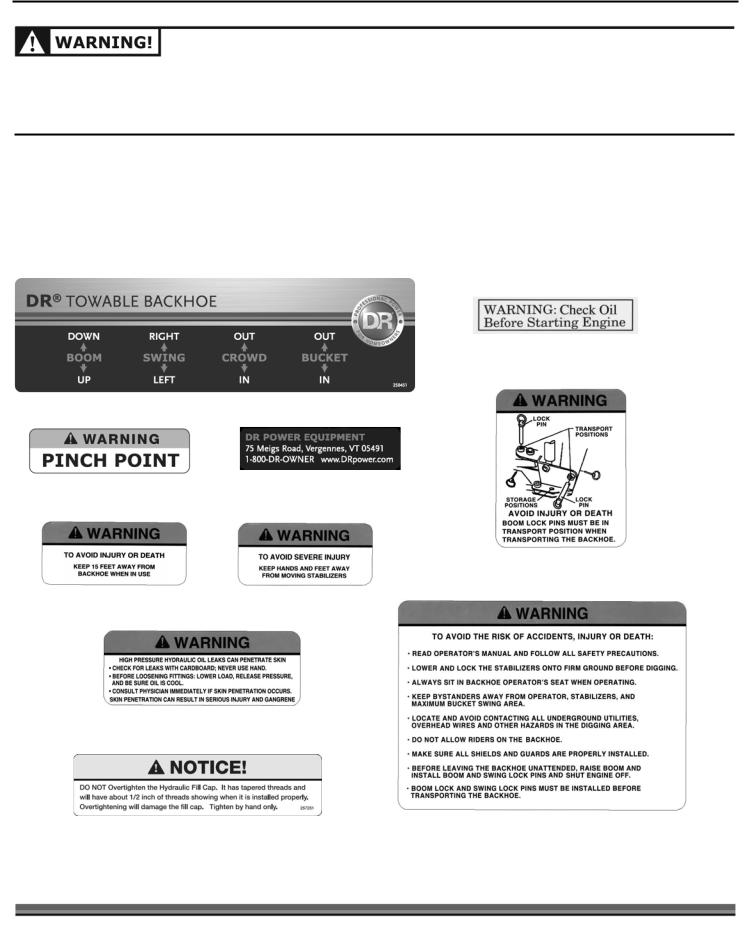
Chapter 1: General Safety Rules
Read this safety & operating Instructions manual before you use the DR TOWABLE BACKHOE. Become familiar with the operation and service recommendations to ensure the best performance from your machine. If you have any questions or need assistance, please contact us at www.DRpower.com or call toll-free 1-800-DR-OWNER (376-9637) and one of our Technical Support Representatives will be happy to help you.
Labels
Your DR TOWABLE BACKHOE carries prominent labels as reminders for its proper and safe use. Shown below are copies of all the Safety and Information labels that appear on the equipment. Take a moment to study them and make a note of their location on your Backhoe as you set up and before you operate the unit. Replace damaged or missing safety and information labels immediately.
#137581
#256191
#250441 |
#235451 |
#245871
#245441 |
|
#245701 |
|
|
|
#246041
#257251 |
#245851 |
CONTACT US AT www.DRpower.com |
3 |
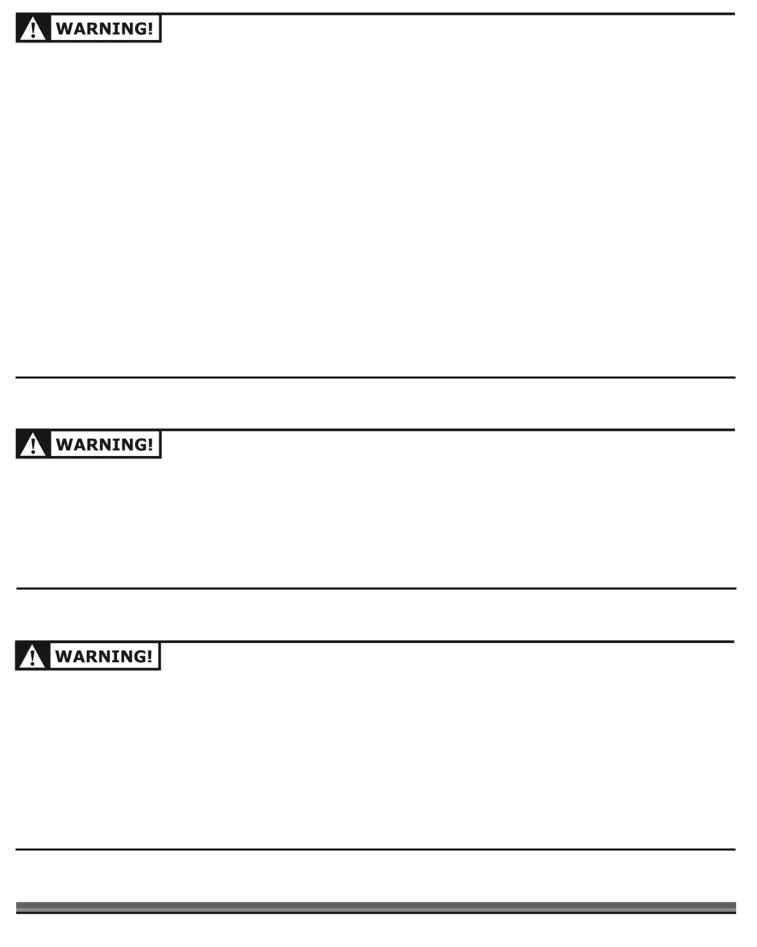
Protecting Yourself and Those Around You
This is a high-powered machine, with moving parts operating with high energy. You must operate the machine safely. Unsafe operation can create a number of hazards for you, as well as anyone else in the nearby area. Always take the following precautions when using this machine:
•Keep in mind that the operator or user is responsible for accidents or hazards occurring to other people, their property, and themselves.
•Always wear protective goggles or safety glasses with side shields while using the backhoe to protect your eyes from possible thrown debris.
•Avoid wearing loose clothing or jewelry, which can catch on moving parts.
•We recommend wearing gloves while using the backhoe. Be sure your gloves fit properly and do not have loose cuffs or drawstrings.
•Wear shoes with non-slip treads when using your backhoe. If you have safety shoes, we recommend wearing them. Do not use the machine while barefoot or wearing open sandals.
•Wear long pants while operating the backhoe.
•Use ear protectors or ear plugs rated for at least 20 dba to protect your hearing.
•Keep bystanders at least 100 feet away from your work area at all times. Lower the bucket and stop the engine when another person or pet approaches.
•Position a barricade around the work area.
•Never allow a person to work under a raised bucket.
•Never lift a person with the backhoe.
Safety for Children and Pets
Tragic accidents can occur if the operator is not alert to the presence of children and pets. Children are often attracted to the machine and the digging activity. Never assume that children will remain where you last saw them. Always follow these precautions:
•Keep children and pets at least 100 feet from the working area and ensure they are under the watchful care of a responsible adult.
•Be alert and turn the machine off if children or pets enter the work area.
•Never allow children to operate the backhoe.
Safety with Gasoline - Powered Machines
Gasoline is a highly flammable liquid. Gasoline also gives off flammable vapor that can be easily ignited and cause a fire or explosion. Never overlook the hazards of gasoline. Always follow these precautions:
•Never run the engine in an enclosed area or without proper ventilation as the exhaust from the engine contains carbon monoxide, which is an odorless, tasteless, and deadly poisonous gas.
•Store all fuel and oil in containers specifically designed and approved for this purpose and keep away from heat and open flame, and out of the reach of children.
•Replace rubber fuel lines and grommets when worn or damaged and after 5 years of use.
•Fill the gasoline tank outdoors with the engine off and allow the engine to cool completely. Don't handle gasoline if you or anyone nearby is smoking, or if you're near anything that could cause it to ignite or explode. Reinstall the fuel tank Cap and fuel container cap securely.
4 DR® TOWABLE BACKHOE
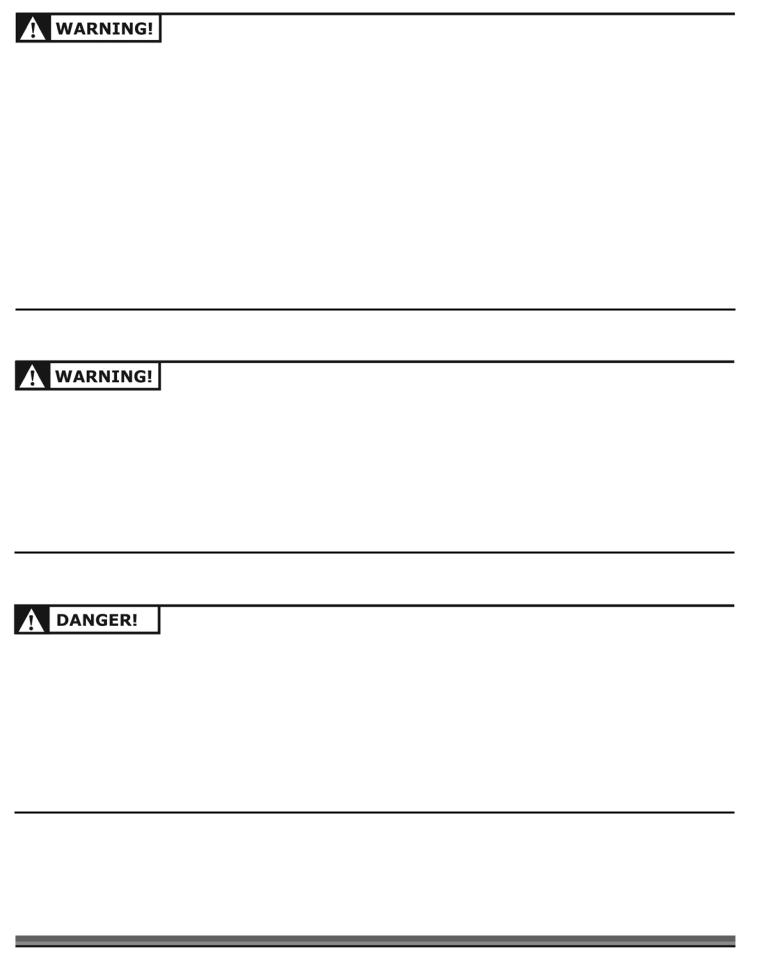
•If you spill gasoline, do not attempt to start the engine. Move the machine away from the area of the spill and avoid creating any source of ignition until the gas vapors have dissipated. Wipe up any spilled fuel to prevent a fire hazard and properly dispose of the waste.
•Allow the engine to cool completely before storing in any enclosure. Never store a machine that has gas in the tank, or a fuel container, near an open flame or spark such as a water heater, space heater, clothes dryer or furnace.
•Never make adjustments or repairs with the engine running. Shut down the engine, disconnect the spark plug wire, keeping it away from the spark plug to prevent accidental starting, wait 5 minutes before making adjustments or repairs.
•Never tamper with the engine’s governor setting. The governor controls the maximum safe operation speed and protects the engine. Over-speeding the engine is dangerous and will cause damage to the engine and to the other moving parts of the machine. If required, see your authorized dealer for engine governor adjustments.
•Keep combustible substances away from the engine when it is hot.
•Never cover the machine while the muffler is still hot.
•Do not operate the engine with the air cleaner or the carburetor air intake cover removed. Removal of such parts could create a fire hazard. Do not use flammable solutions to clean the air filter.
•The muffler and engine become very hot and can cause a severe burn; do not touch.
Hydraulic Safety
High fluid pressures are developed in hydraulic machines. Pressurized hydraulic fluid escaping through a pin hole opening can puncture skin and cause severe blood poisoning. Therefore, the following Instructions should be heeded at all times.
•Do not operate the unit with frayed, kinked, cracked or damaged hoses, fittings, or tubing. Stop the engine, wait 5 minutes and relieve hydraulic system pressure before changing or adjusting fittings, hoses, tubing, or other system components.
•Do not change any backhoe relief valve settings. They are set at the factory for best backhoe performance and safety.
•Do not check for leaks with your hand. Leaks can be located by passing cardboard or wood over the suspected area: Look for discoloration. If injured by escaping fluid, see a doctor at once. Serious infection or reaction can develop if proper medical treatment is not administered immediately.
•Always wear safety glasses to protect your eyes from hydraulic fluid.
Safety When Digging Near Utilities
Call 811 before you begin any digging project. A new, federally-mandated national "Call Before You Dig" number, 811 was created to help protect you from unintentionally hitting underground utilities while working on digging projects. Every digging job requires a call. If you hit an underground utility line while digging, you can harm yourself or those around you, disrupt service and potentially be responsible for fines and repair costs.
•There may be buried power, gas, and/or telephone lines in the work area. Electric shock, death, or explosion may occur.
•Have the property or work area marked for buried lines and do not dig in marked areas.
•There may also be overhead power lines in the work area. electric shock or death may occur if a power line is touched by the backhoe.
•Survey and mark the area where there are overhead power lines and dig with caution under power lines to ensure that you do not touch them with the backhoe.
CONTACT US AT www.DRpower.com |
5 |

Towing
•ALWAYS check before towing to make certain your backhoe is correctly and securely attached to the towing vehicle. Be sure that the ball hitch you are using is the proper size for the hitch coupler on the backhoe. Be sure the safety chains are properly hooked to the vehicle leaving enough slack for turning.
•ALWAYS install the swing and boom transport hitch pins and lynch pins before transporting the backhoe.
•ALWAYS use accessory lights and devices when transporting on a road or highway to warn operators of other vehicles. Check your local government regulations for DOT information.
•ALWAYS allow for added length of the backhoe when turning, parking, crossing intersections, and in all driving situations.
•ALWAYS be careful when backing up. You could jackknife your backhoe if care is not taken.
•NEVER exceed 45 mph. when towing your backhoe. Obey all state and local regulations when towing on state and local roads and highways. Adjust your speed for terrain and conditions, as needed. Be extra cautious when towing over rough terrain, especially over a railroad crossing.
•NEVER allow anyone to sit or ride on your backhoe.
•NEVER carry any cargo on your backhoe.
•Do travel slowly over rough terrain, on hillsides, and around curves to prevent tipping.
•Do not tow the backhoe near the edge of a ditch or excavation.
General Safety
Operating this backhoe safely is necessary to prevent or minimize the risk of death or serious injury. Unsafe operation can create a number of hazards for you. Always take the following precautions when operating this backhoe:
•Your backhoe is a powerful tool, not a plaything. Exercise extreme caution at all times. The machine is designed to dig. Do not use it for any other purpose.
•Know how to stop the backhoe quickly; see “stopping the engine” in chapter 4.
•Operate this machine on a level surface only. Never operate your unit on a slippery, wet, muddy, or icy surface. Exercise caution to avoid slipping or falling.
•Never dig with the backhoe unless the stabilizers are properly set or the Backhoe could tip forward.
•Be sure the area is clear of underground obstructions. Call “811” before you dig.
•See manufacturer’s instructions for proper operation and installation of accessories. Only use accessories approved by DR Power Equipment.
•Never use the machine without ensuring that all guards and shields are in place.
•Never, under any conditions, remove, bend, cut, fit, weld, or otherwise alter standard parts on the backhoe. This includes all shields and guards. Modifications to your machine could cause personal injuries and property damage and will void your warranty.
•Always operate the backhoe from the operator seat only.
•Allow only one person to operate the backhoe at any time.
•Do not dig under the stabilizers. Soft ground or sandy soil can cause cave-ins.
•Do not use the backhoe bucket as a battering ram.
•Always lower the bucket to the ground before leaving the operator’s seat.
•Never leave the backhoe with the engine running. Stop the engine by turning the ignition switch to “off”.
•Use the steps provided when climbing on or off the backhoe to prevent slipping.
•If the machine should start making an unusual noise or vibration, shut down the engine, disconnect the spark plug wire, keeping it away from the spark plug to prevent accidental starting, wait 5 minutes, then inspect for damage. Vibration is generally a warning of trouble. Check for damaged parts and clean, repair and/or replace as necessary.
•Never tamper with safety devices. Check their proper operation regularly.
6 DR® TOWABLE BACKHOE

•Before performing any maintenance/inspection procedure or before leaving the backhoe unattended, raise and center the boom, lower the crowd arm, pull in the bucket, adjust the throttle control lever to idle, turn the ignition switch to “off”, remove the spark plug wire, and install the swing and boom transport hitch pins and lynch pins.
•Never allow people who are unfamiliar with these instructions to use the backhoe. Allow only responsible individuals who are familiar with these rules of safe operation to use your machine.
•Never overload or attempt to move material beyond the manufacturer’s recommendation. Personal injury or damage to the machine could result.
•While using the backhoe, don't hurry or take things for granted. When in doubt about the equipment or your surroundings, stop the machine and take the time to look things over.
•Never operate the machine when under the influence of alcohol, drugs, or medication.
•Use the machine only in daylight.
•Stay alert for hidden hazards or traffic.
•Keep all nuts and bolts tight and keep the equipment in good operating condition.
A Note to All Users
Under California law, and the laws of some other states, you are not permitted to operate an internal combustion engine using hydrocarbon fuels without an engine spark arrester. This also applies to operation on US Forest Lands. All DR® TOWABLE BACKHOES shipped to California, New Mexico and Washington State are provided with spark arresters. Failure of the owner or operator to maintain this equipment in compliance with state regulations is a misdemeanor under California law and may be in violation of other state and/or federal regulations. Contact your State Park Association or the appropriate state organization for specific information in your area.
No list of warnings and cautions can be all-inclusive. If situations occur that are not covered by this manual, the operator must apply common sense and operate this DR TOWABLE BACKHOE in a safe manner. Contact us at www.DRpower.com or call 1- 800-DR-OWNER (376-9637) for assistance.
CONTACT US AT www.DRpower.com |
7 |
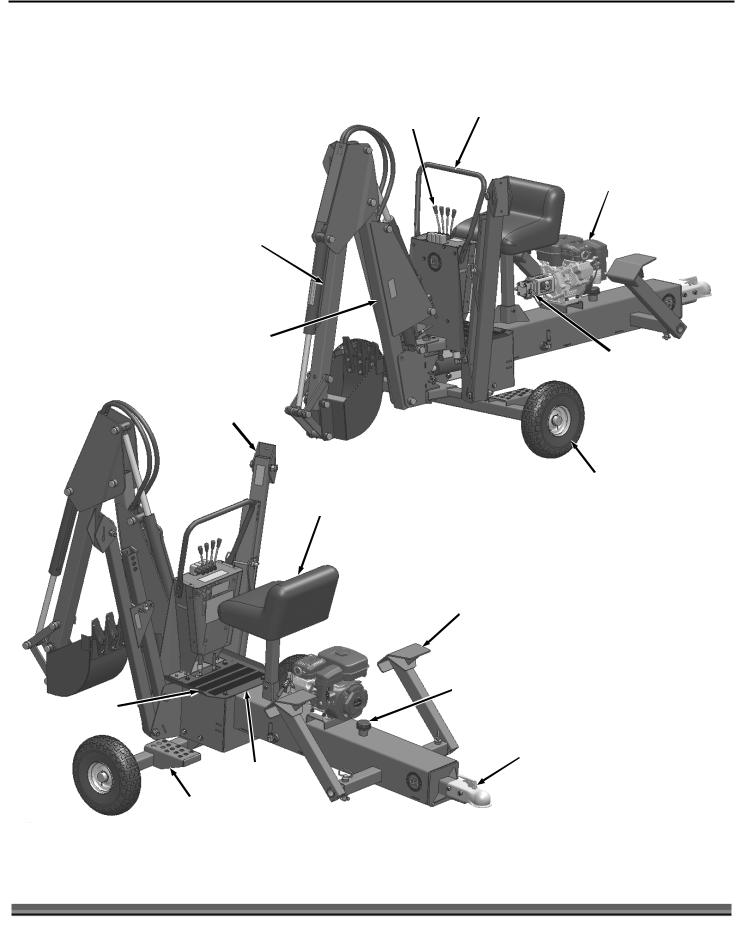
Chapter 2: Setting Up The DR TOWABLE BACKHOE
It may be helpful to familiarize yourself with the controls and features of your DR TOWABLE BACKHOE as shown in Figure 1 before beginning these procedures. If you have any questions at all, please feel free to contact us at www.DRpower.com.
DR TOWABLE BACKHOE
Controls and Features
Crowd
Arm
Boom
Front
Stabilizers
Operator
Seat
Handle
Control Valve Guard
Assembly
 12" Bucket
12" Bucket
(9" and 16" Bucket
and Ripper Tooth
Optional)
Rear
Stabilizers
Hydraulic
Foot Tank Fill
Plate
|
Hydraulic |
|
|
Fluid Filter |
|
Operator |
(under Foot |
|
Plate) |
||
Step |
||
|
Figure 1
Tow
Hitch
Engine
Hydraulic
Pump
Pneumatic
Wheel
8 DR® TOWABLE BACKHOE

Specifications
MECHANICAL SPECIFICATIONS
Engine |
6HP Subaru Manual-Start |
9HP Subaru Manual-Start |
Displacement |
169cc |
265cc |
Max. HP |
6 (4.5 kW)/4000 rpm |
9 (6.71 kW)/4000 rpm |
Torque |
8.34 ft. lbs. (11.3 N.m.)/2500 rpm |
13.74 ft. lbs. (13.74 Nm)/2500 rpm |
Fuel Capacity |
.90 Gallons (3.4 Liters) |
1.59 Gallons (6.1 Liters) |
Oil Capacity |
1.3 pints (0.60 Liter) |
33.8 oz. (1.0 Liter) |
Tire Size |
4.80/4.00-8 Pneumatic |
4.80/4.00-8 Pneumatic |
Digging Depth |
76.5" |
76.5" |
Horizontal Reach |
104.5" |
104.5" |
Bucket Size - Standard |
12" |
12" |
Max. Digging Radius |
128 degrees |
128 degrees |
Lubrication |
15 Grease Fittings at pivot points |
15 Grease Fittings at pivot points |
Bucket Rotation |
148 degrees |
148 degrees |
Tow Ball Size |
2" Ball |
2" Ball |
Towing Speed |
45 mph maximum |
45 mph maximum |
Front Stabilizers Width |
Down 116"/Up 53" |
Down 116"/Up 53" |
Dry Weight |
920 lbs. |
932 lbs |
Operating Weight |
965 lbs. |
977.lbs |
Shipping Dimensions |
101" l x 69" w x 69" h |
101" l x 69" w x 69" h |
Shipping Weight |
940 lbs. |
952 |
HYDRAULIC SPECIFICATIONS
Hydraulic Tank |
8.5 gallons (maximum recommended) |
Hydraulic System |
9.4 gallon (including tank, cylinder, hoses, filter) |
Hydraulic Fluid Filter |
Spin-on type |
Fluid Strainer |
In-tank suction strainer |
Gear Pump |
Single stage, 2.788 gallons per minute |
Hydraulic Fluid |
Universal Hydraulic Fluid (ISO 32) |
Unpacking the Backhoe
Tools Needed:
• Utility Knife
1.Cut the Plastic Wrap from the Backhoe and remove all cardboard.
2.Cut all Plastic Straps that are securing the Boom and Bucket.
Adding Oil and Gasoline
Engine Oil |
SAE 30: above 40 degrees F; 10w-30: 10-90 degrees F; 5w-30: |
|
40 degrees F or below |
|
|
Fuel |
Unleaded gasoline |
CONTACT US AT www.DRpower.com |
9 |

•You must add oil before starting the engine. This machine is shipped without oil. Traces of oil may be in the reservoir from factory testing, but you must add oil before starting the engine. Fill the reservoir slowly, checking the level frequently to avoid overfilling.
•To get an accurate reading when checking the oil level:
-the machine should be on a level surface.
-the dipstick should not be screwed down to ensure an accurate oil level reading.
Oil Fill/Dipstick
Figure 2
Gas Fill Cap
NOTE: Use only the recommended high detergent engine oil. Other types of oil Full Low could cause problems operating your machine. Please refer to your Engine Owner’s
Manual for detailed oil information.
1.Place the machine on a level surface, remove the Oil Fill/Dipstick (Figure 2) and clean the end of it with a rag.
2.Machines are shipped with no oil. Initially add 16 oz. of the oil recommended by the Engine Manufacturer. Wait one minute for the oil to settle.
3.Replace the Dipstick, but DO NOT screw it in, to ensure an accurate reading and then remove it to check the oil level (clean the Dipstick with the rag after checking).
4.Continue adding a few ounces of oil at a time, rechecking the Dipstick until the oil reaches the fill mark. Be careful not to overfill.
5.Replace the Dipstick and screw all the way down when full.
6.Remove the Gas Fill Cap and fill the Gas Tank with fresh, unleaded gas (with a minimum of 85 Octane) to approximately 1" to 1-1/2" below the top of the fill neck to allow for fuel expansion (Figure 3). Be careful not to overfill and reinstall the Gas Fill Cap before starting the engine. See your Engine Owner’s Manual for more detailed information.
NOTE: To refill the gas tank, turn the engine OFF and let the engine cool at least five minutes before removing the gas fill cap.
Figure 3
10 DR® TOWABLE BACKHOE
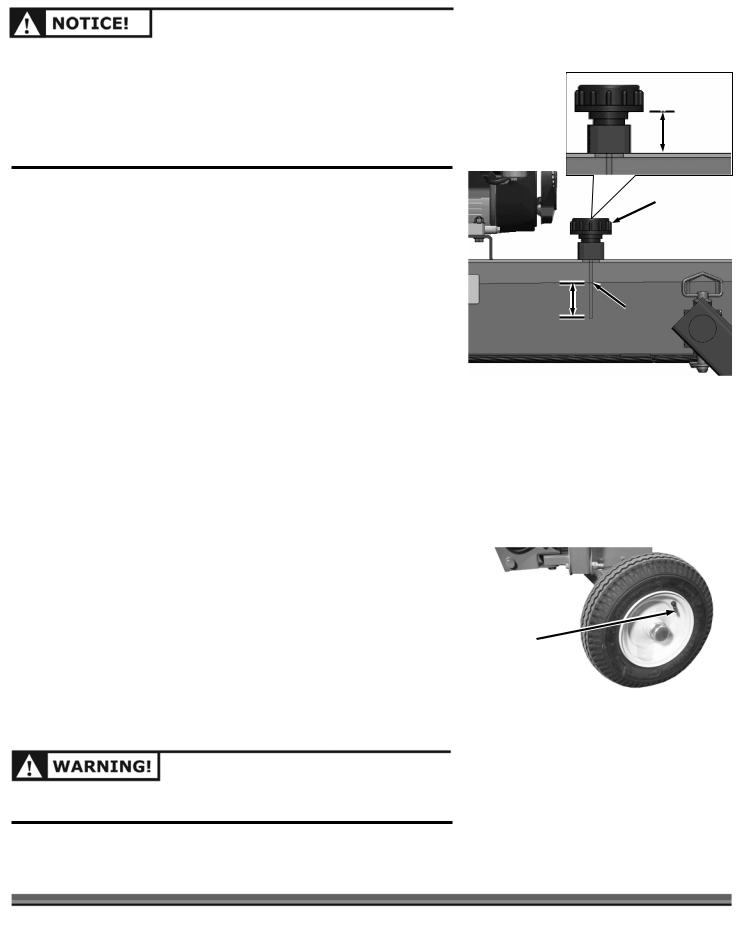
Adding Hydraulic Fluid
•You must add hydraulic fluid before using the backhoe. This machine is shipped without hydraulic fluid in the hydraulic tank. Fill the hydraulic tank slowly, checking the level frequently to avoid overfilling.
•To get an accurate reading when checking the hydraulic fluid level:
-the machine should be on a level surface.
-the dipstick should be screwed on to ensure an accurate fluid level reading.
TIP: Check the Fluid level by removing the Hydraulic Fluid Filler Cap and wiping the steel rod of the Dipstick with a clean Rag or Paper Towel. Reinsert and tighten the Cap to the proper position (1-3/4" from the bottom of the Cap to the top of the Tank) (Figure 4). Remove the Cap and lay the Steel Rod onto a dry Paper Towel or Rag and read the level by the wet mark that is transferred from the Steel Rod to the Rag.
1.Remove the Hydraulic Fluid Fill Cap Dipstick and fill the Hydraulic Tank with the recommended fluid (see the “Specifications” section, page 2).
NOTE: The tank is full when the fluid level is within the recommended level on the Dipstick. The recommended level is in the middle (2-3/8" up from the bottom) of the Steel Rod. Do not deviate more than 1/2" up or down from that point. If the fluid level is not within this range, fluid must be added or removed to bring it within that range.
NOTE: The total hydraulic system fluid capacity is 9.4 gallons. The operator should initially only need to add about 8 gallons before checking the level because some fluid has already been added to the Cylinders.
Check the Tire Pressure
Tools Needed:
•Tire Pressure Gauge
•Air Compressor
1.Remove the Valve Stem Protective Cap (Figure 5) and check the tire pressure with a Tire Pressure Gauge.
2.Check what the manufacturers recommended pressure is that is stamped on the side of the Tire.
3.If the pressure is too low, add air through the Valve Stem with an air hose.
4.Replace the Valve Stem Protective Cap when finished.
Do not over inflate the tires. Inflate to the manufacturers recommended pressure found on the tires.
2-3/8"
Figure 4
Valve Stem
Protective Cap
Figure 5
 1-3/4"
1-3/4"
Hydraulic
Fluid Fill Cap
Fluid Half
Way on the
Steel Rod
CONTACT US AT www.DRpower.com |
11 |

Chapter 3: Operating The DR TOWABLE BACKHOE
Swing Control |
Crowd Arm |
|
Lever |
Control Lever |
Bucket |
|
|
|
|
|
Control |
|
|
Lever |
Boom
Control
Lever Operation
Label
Figure 6
It may be helpful to better familiarize yourself with the features of your Backhoe by reviewing Figure 1 in Chapter 2 before beginning the steps outlined in this chapter.
Read and understand the dangers listed in the “Safety When Digging Near Utilities” section in “Chapter 2 General Safety Rules” before operating this Backhoe.
Read and understand all warnings listed in “Chapter 2 General Safety Rules” before operating this backhoe.
Crowd and Bucket
Control Lever
Boom and Swing
Control Lever
Operation
Label
Figure 7
Off
Ignition
Switch
On
Figure 8
12 DR® TOWABLE BACKHOE
Control Levers
1.Familiarize yourself with all of the Control Levers (Figure 6) and all of their functions by studying the Operation Label before operating the Backhoe. Figure 7 shows the Joystick option.
Starting the Engine
1.Turn the Ignition Switch to the “ON” position (Figure 8).
2.Make sure the Fuel Shut-off is in the “OPEN” position (Figure 9).
Throttle Lever
Choke
Lever
Fuel
Shut-off
Starter
Cord
Figure 9
